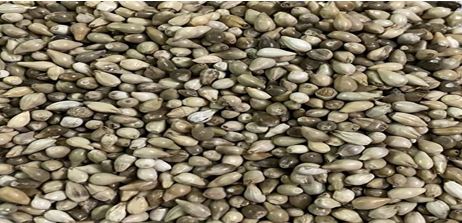A critical review of Millets with special reference to Ayurveda
DOI:
https://doi.org/10.21760/jaims.9.6.32Keywords:
Millets, Shree Anna, Siri Dhanya, Kudhanya, Trina DhanyaAbstract
Millets are a traditional staple food of the dry land regions of the world. In India, millets are grown on about 17 million hectares with annual production of 18 million tones and it contributes 10 percent to the country’s food grain basket. In a visionary move the government of India proposed to united nation to designed 2023 as the international year of millets as 72 countries rallied behind the passes the UN general assembly recognized 2023 as the year to celebrate this humble grains. The available cultivable plant‐based food resources in developing tropical countries are inadequate to supply proteins for both human and animals. Millets are an important food crop at a global level with a significant economic impact on developing countries, Millets are considered as high‐energy yielding nourishing foods which help in addressing malnutrition. Grains of these millet species are widely consumed as a source of traditional medicines and important food to preserve health. Choosing millets as part of diet is a small step with a big impact these grain often overlooked contribute to personal health and environmental sustainability. Rich in nutrients, gluten-free and resilient in diverse climates, millets offer a sustainable alternative that can make a significant difference in both individual well-being and global food systems.
Downloads
References
Robert, F. 2000. The words of medicine. Charles C Thomas Publisher Ltd., Springfield, USA, p.121.
Macdonell, A.A. and Keith, A.B. 1958. Vedic Index of Names and Subjects, Motilal Banarasi Das,Delhi, India, p.208.
Bindu, S. 2010. Medicinal plants in Vedas, Chaukhamba Vishwabharti, Varanasi, p.35.
Shastri, A.D. 2011. Sushruta Samhita of Sharira, Ayurveda Tatava Sandipika Commentary, Chaukhamba Sanskrit Sansthan, Varanasi, India.
Gupta, K.A. 2011. Ashtang Hridaya of Vagbhat, vidyotini Hindi Commentary, Chaukhambha Prakashan Varanasi Sutra Sthana.
Acharya Charaka. Sutrasthana, Annapanavidhi Adhyaya. In: Vaidya Jadavaji Trikamji Acharya (ed.) Charaka Samhitha. Delhi: Chaukhamba Prakashan; 2011. p. 154.
Bhavamishra. Dhanyavarga. Dr K.C. Chunekar (cm.) Dr G.S Pandey (ed.) Bhavaprakasha Nighantu Varanasi: Chowkhamba Bharti Academy; 2002. p. 656 - 661.
Amir Gull., Romee Jan., Gulzar Ahmad Nayik., Kamlesh Prasad and Pradyuman Kumar, Significance of Finger Millet in Nutrition, Health, and Value - added Products: A Review: Journal of Food Processing & Technology 2014: Vol.3.No.3, 1601 – 1608
Sarita, Ekta Singh. The potential of Millets: Nutrients Composition and Health Benefits. Journal of Scientific and Innovative Research, 2016 5(2): 46 – 50.
Zerihun tadele. Drought Adaptation in Millets. [Online]. Available from: https://www.intechopen.com/books/abiotic-andbiotic-stress-in-plants-recent-adva nces-and-future perspectives/drought-adaptation-in-millets [Accessed 31 March 2021].
Das, I.K, Padmaja, P.G. Biotic Stress Resistance in Millets. (1st ed.).: Elsevier; 2017.
Baker, R.D. Millet Production. [Online]. Available from: http://agrilife.org/lubbock/files/2011/10/MilletProduction.pdf [Accessed 31 March 2021].
Amadou I, Gounga ME, Le GW. Millets: Nutritional composition, some health benefits and processing-A review. Emirates Journal of Food and Agriculture. 2013 May 1:501-8.
Sarita ES, Singh E. Potential of millets: nutrients composition and health benefits. Journal of Scientific and Innovative Research. 2016;5(2):46-50.
Taylor JR, Emmambux MN. Gluten-free foods and beverages from millets. InGluten-free cereal products and beverages 2008 Jan 1 (pp. 119-V). Academic Press.
Bora P, Ragaee S, Marcone M. Characterisation of several types of millets as functional food ingredients. International journal of food sciences and nutrition. 2019 Aug 18;70(6):714-24.
Serna-Saldivar SO, Espinosa-Ramírez J. Grain structure and grain chemical composition. InSorghum and Millets 2019 Jan 1 (pp. 85-129). AACC International Press.
Charak Samhita Hindi Commentry, Sharma Acharya Priya Vrat, Sukla Acharya Vidhyadhar and Tripathi Prof.Ravidatt, Chaukhamba Sanskrit Pratisthan Delhi, E-Sutra Sthan, 2009; 1: 390.
Pooja Hassan G, Unnikrishnan PM, Sankanagoud Patil; An eyeshot on Kshudra Dhanya in Ayurveda, Journal of Ayurveda and Integrated Medical sciences, July - Aug 2021, Vol. 6, Issue 4.
Obilana AB, Manyasa E. Millets. InPseudocereals and less common cereals 2002 (pp. 177-217). Springer, Berlin, Heidelberg.
Geervani P, Eggum BO. Nutrient composition and protein quality of minor millets. Plant Foods for Human Nutrition. 1989 Jun 1;39(2):201-8.















